Best Pond Maintenance Tools to Buy in December 2025
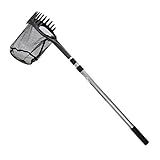
Aquascape Pond Shark PRO, 3-in-1 Professional Pond Net with Rake and Scraper, Heavy-Duty Design, Telescopic Handle Extends to 96 Inches, Ideal for Pond Cleaning and Maintenance
- EFFICIENT 3-IN-1 TOOL FOR QUICK POND MAINTENANCE
- HEAVY-DUTY NET SAFELY HANDLES FISH AND DEBRIS
- TELESCOPING HANDLE REACHES DEEP PONDS WITH EASE



TetraPond Telescoping Pond Net, 14-Inch Diameter Ring
- EFFORTLESSLY CLEAN PONDS WITH A 14 DIAMETER AND 16 DEEP NET.
- EXTENDABLE 5 FT HANDLE REACHES ALL CORNERS SAFELY AND EASILY.
- TRUSTED TETRA QUALITY FOR SAFE FISH RETRIEVAL AND DEBRIS REMOVAL.


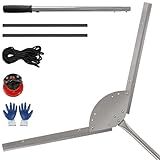
Zynthrafor Adjustable Lake Weed Cutter, Pond Aquatic Plant Cutting Tool for Cattail, Phragmites, Lilly Pads& Chara, with 37/25/12 Three Cut Width, 30ft Rope, Sharp Blades, Blade Sharpener & Gloves
-
ADJUSTABLE BLADE WIDTH: CUSTOMIZE CUTTING WIDTH FOR ANY WATER BODY.
-
DEEP ROOT CUTTING: EFFICIENTLY REDUCES REGROWTH WITH SHARP V-BLADE.
-
DURABLE STAINLESS STEEL: CORROSION-RESISTANT FOR LONG-LASTING USE.


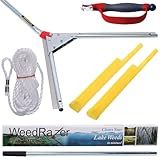
Jenlis Weed Razer Express, Lake Weed Cutter, Compact Aquatic Pond Plant Cutting Tool, Sharp Razor Blades Shear Cattail, Reed, Phragmites Lilly & Chara Algae, 30” Inch Cut Width, 25 Foot Throw Rope
-
V-SHAPED BLADES: CUT 30-INCH PATHS THROUGH POND WEEDS SWIFTLY!
-
LIGHTWEIGHT DESIGN: JUST 6 LBS FOR EASY USE AND QUICK THROWING!
-
CHEMICAL-FREE: EFFECTIVE WEED CONTROL WITHOUT HARMFUL CHEMICALS!


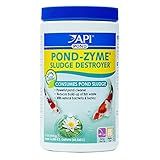
API POND-ZYME SLUDGE DESTROYER Pond Cleaner With Natural Pond Bacteria And Barley, 1-Pound Container
- NATURALLY BREAKS DOWN FISH WASTE AND POND SLUDGE FOR A CLEANER POND.
- REDUCES POND MAINTENANCE WITH EFFECTIVE ALGAE AND DEBRIS DIGESTION.
- EASY USE: TWICE A WEEK FOR START-UP, THEN BI-WEEKLY FOR UPKEEP.


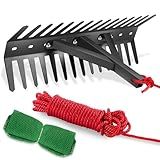
YIVIKPE Pond Rake, Weed Removal Tool, Steel Blades 24 inch Aquatic Weed Rake, Double Sided Lake Weed Cutter, Clean Aquatic Weeds Muck Silt Lake Rakes, 30ft Thicker Rope, Black.
-
EASY ASSEMBLY: INSTALL YOUR WEED CUTTER IN JUST 5-10 MINUTES.
-
EFFECTIVE CLEANING: 8.3 TEETH TACKLE PESKY AQUATIC PLANTS EFFORTLESSLY.
-
INCLUDED ACCESSORIES: COMES WITH A THICKER ROPE AND NET FOR EASY CLEANUP.


Now that spring is just around the corner it’s time to begin the loving task of opening up the pond. The transition of winter to spring can be tricky for the fish. Parasites and anaerobic (bad) bacteria thrive in cool waters before the fish have had time to build up their immunity. Aerobic (good nitrifying) bacteria take their time to establish in the biological filter so we run the risk of deadly ammonia and nitrite build-up in the pond during this time of year.
Follow the steps below to help achieve the best possible transition into season for your pond:
Spring Cleaning
The pond should be cleaned thoroughly at least once a year though it’s best to do it twice - once in fall and then again in early spring. Now is the time to do the spring cleaning before nitrifying bacteria have had a chance to wake up. Remember not to scrub the sides while cleaning it. The gel coating on the sides of the pond are healthy. The trash on the bottom of the pond is not. If you are not keen on cleaning the pond yourself we have professional services available.
Do-It-Yourselfers can get all the details of how to perform a thorough pond cleaning by reading our article, “It’s Cleaning Time” found on our website at this address: http://www.ponddoc.com/WhatsUpDoc/Seasonal/Cleaning.htm
Clean the Filter
Many of us turn off the filtering system during winter because there’s more reasons not to run the pond than to run it. The pads or beads of the filter have built up major yucky stuff from sitting still. Even if water flowed through the filter during winter it’s a great idea to start the season with clean filtering material.
We strongly suggest that a yearly maintenance be performed on all bead filters at this time of year. When beads cake up the filter can become rancid and breed bad bacteria. It doesn’t matter if a blower is attached and it doesn’t matter what brand bead filter you have. Get inside the unit and manually break up the beads then perform a power backwash BEFORE running water through the filter and back to the pond. Some people prefer to simply change out the beads. This is not necessary if you clean the beads. Replacing the biological filtering material may effectively sterilize your filter and it will set the biological filter back to square one with its job of growing beneficial bacteria. We can come out and perform a bead filter maintenance service if you don’t care to do it yourself.
Salt the Pond
You hear a lot about keeping the pond salted at a low level. We know why folks subscribe to this theory and it has it’s merits. We do not, however, subscribe to this idea because we use salt as a low-risk, natural way to treat the pond and fish for parasites. Parasites become immune to salt when exposed to small amounts over a period of time. This immunity has become evident with the discovery of costia (a parasite that causes death in fish) so immune to salt that it takes twice the dosage to kill it. When you consider the treatment dosage of salt is 3 lbs. per 100 gallons - 6 lbs. brings the salt level up so high that it becomes stressful on the fish.
Non-iodized salt, when dosed at 3 lbs. per 100 gallons, kills many of the common parasites that can kill or lead to the death of koi and goldfish. It also naturally promotes a healthy slime coat on the fish. Chemicals that claim to coat the fish are available but the bad part of using them is that they also coat the gills of the fish and can make it difficult for the fish to breathe. A good two to three-week salt treatment is the best preventative medicine on the market and also the cheapest. A treatment done in early spring before the plants have had time to sprout will save you from having to remove them. Anacharis and other submerged plants that stay green during the winter should be removed during the process. When the salt treatment is finished simply change out 50% of the water twice in the span of a couple of weeks (don’t forget to add declor if using chlorinated tap water) to dilute the salt.
Fluke tabs treatments along with the salt is a great regimen to use during quarantine as well as a precaution during spring opening. Salt will not kill flukes, a common and deadly parasite. New pond-sized fluke tabs are available, making using this medication easier and less expensive than before.
Potassium Permanganate Treatment
Potassium Permanganate is an inexpensive oxidizer that strips pond walls and surfaces of bacteria and kills parasites such as flukes that salt will not kill. We prescribe “PP Treatments” when koi and goldfish are suffering from acute and/or reoccurring bacterial infections and fluke infestations. It’s also a very effective alternative method of preventing problems that arise during the cooler water times of early spring when flukes and other parasites thrive but the immunity systems of the fish are not up to par.
It can, however, be easily overdosed and kill fish as well. It is very important to know the exact gallonage of a pond to perform a PP treatment correctly. We tend to reserve this method of treatment for ponds that belong to more experienced pond keepers. As long as the treatment is given correctly it is an inexpensive alternative to costly medications and water treatments. It is a very effective step to help prevent health problems in early spring and we perform it on all our ponds that contain fish when we open them up for the new season.
Prepare the Plants
Many water plants are hardy and will come back in the spring. The leaves of the plants brown out and die back when winter chills them. Then through winter they lie on the bottom of the pond or on pond shelves looking like pots of dirt instead of lush plants. Don’t throw away these pots of dirt unless you know that the plant was a tropical plant. A good rule of thumb is that if there is no sprout of new growth in the pot by the middle of April it’s safe to throw out.
If you lowered your plants to the bottom of the pond for the winter now is the time to raise them. Most hardy water lilies do NOT need to be raised if the pond is less than 5 feet deep. Cut away any browned material left over from last season. Fertilize each marginal with 1 PondTab fertilizer tab stuck down into the soil as far as your finger will push it. Use 2 tabs for each hardy water lily and 5 for each lotus. When fertilizing lotus be aware of the roots and do not press down on them. They are hollow and may puncture, thus killing the plant.
If the sides of the pots are bulging or the root itself is jumping the pot (common in water lilies) you should split the plant into at least two separate containers. Most water plants, especially water lilies, do not grow and show as well when over-crowded. It’s easy to distinguish separate plants on water lily roots because the first tiny leaves grow in clusters. Simply cut through the root with a sharp knife between the clusters and repot them. Most marginal and bog plants can be divided into sections by pulling and cutting through the root masses, very similarly to dividing perennials. Use soil that is void of nutrients and heavy. Top off with small stones to keep the soil in and make the top of the pot attractive. Soiless potting media is available for anyone who would like to keep a cleaner pond.
Plants to buy will become more and more available as spring matures. Irises are one of the few water plants that stay green all winter. They will also be the very first plant to bloom. The first green plants we’ll see (middle of March) will be rushes and umbrella palms followed by more exotic species as the waters warm. The tropical floaters (water hyacinths and water lettuce) will not be available for sale until after the last frost as are tropical water lilies and delicate marginal or bog plants. The last type of water plant to come in will be the beautiful lotus. We should see fully grown Lotus plants around the first of May.
Protection from Predators
Winter remains the most dangerous time for our fish in the pond because of the absence of plants to conceal them from the blue heron and other birds of prey. Early spring is a close second. Before plants have had a chance to cover the pond our fish are still sluggish and vulnerable to predators. It’s my own theory that mother nature created algae bloom (green water) in spring to give fish a chance. Many of us, however, use UVs to keep the water sparkling clear. We often use decoys to help combat the threat of blue herons because they are territorial creatures - most of the time. A blue heron decoy should be removed during the months of April, May and June (at least in our neck of the woods) because it’s mating season and one might just fall in love with your decoy and come down to have breakfast with his new love interest. The #1 deterrent to blue herons is a deep pond (of 3 feet or over) but if it’s not possible to dig the pond deeper you can also use netting over the pond. A motion-detecting scarecrow is also available to help scare off any type of predator. The problem with it, though, is that it doesn’t distinguish a human from a raccoon.
Feeding the Fish
Pond fish are regulated by water temperature. When it’s cold, koi and goldfish go into a semi-dormancy and do not eat. As water temperatures rise fish begin stirring about and they become more and more their old selves and will want to eat. DO NOT begin feeding your fish until water temperatures rise up to and stay above 55°F. This is for their own good. If the water temperature falls below 55° F the fish cannot digest food. Food can sit inside their intestines, spoil and become toxic. When you do begin feeding them we suggest you start them with a wheat-germ based diet because wheat-germ is easier to digest than protein-enriched regular koi and goldfish foods. We feed our guys M-Wheat.
Once water temperatures rise up to and remain higher than 64° we like to feed them a diet of only triple antibiotic food for a period of two weeks. Three different antibiotics work to prevent bacterial problems so common during the transition to spring. The fish will be ready for their regular spring and summer diet after their regimen of antibiotic food. Feed them koi food rich in protein like our own M-Grow.
UV Maintenance
If you followed instructions that were posted in our last newsletter and removed your ultraviolet water clarifying unit from your pond and stored it high and dry for the winter you get a gold star! For your prize you don’t have to replace the glass parts inside the unit. Once we experience our last freeze water temperatures will rise quickly and it will be time to re-install the UV.
Unfortunately we are already hearing from several folks who did not winterize this delicate piece of equipment and are having to replace several parts. When water freezes it expands. Water sitting in a UV will freeze, expand and break the delicate glass parts inside. I know of two people now who are forced to replace the whole unit because the freezing temperatures in January busted the PVC outer casing and all glass parts inside. If you did not remove the UV it’s highly probable that you will have to replace the quartz sleeve(s) and/or glass lamp(s).
If, after turning on your unit for the first time, your water does not clear and remains green it’s an indication something isn’t working properly with your UV and system. While the UV is on unscrew only the portion at the end that connects the power to the lamp and pull the lamp out just enough to see if it’s lit.
If the lamp is shining - don’t stare at it. It can hurt your eyes. Two things could be wrong. The lamp may simply have lost its strength which happens over a period of a season. Replace the lamp and it should do its job. If the lamp is rather new then it could be that your water is flowing through the UV too quickly or too slowly. Ask yourself if you changed the flow of the water, readjusted the valve or changed the strength of the pump since the last time the UV worked properly.
If the lamp is NOT shining - it could be one or more of three problems. #1 - the lamp may have blown. Remove the lamp and check it for signs of water getting to it such as a white crust around the end where it plugs into the transformer. If water is getting to the lamp the next one you plug in will also blow. Either way, you’ll need to replace the lamp. #2 - the quartz sleeve has a crack in it. This is the most frequent problem we encounter with units left out over winter. With the system turned off unscrew the cap that holds the quartz sleeve and gently inspect the sleeve for even hairline fractures. The smallest crack will allow droplets of water inside the sleeve and will continuously blow the lamp. If it is damaged you must replace the sleeve along with the lamp. #3 - the transformer does not work. This is rare and isn’t attributed much to wintering of the unit. Plug a new lamp into the transformer. If it doesn’t light, chances are the transformer needs to be replaced.
If you are in doubt or nervous about handling your UV or just can’t figure out what’s wrong with it you can bring the whole unit in to us and we’ll check it out for you. We carry a lot of replacement parts for them but if your UV is an odd model that wasn’t purchased through us make sure to give us a call before making the trip just in case we’re not familiar with your brand of UV.
